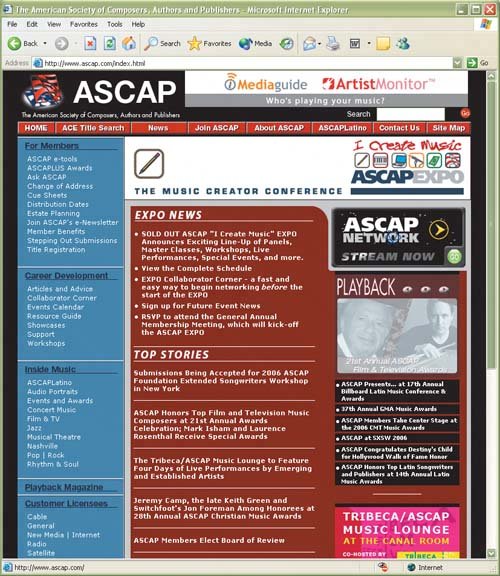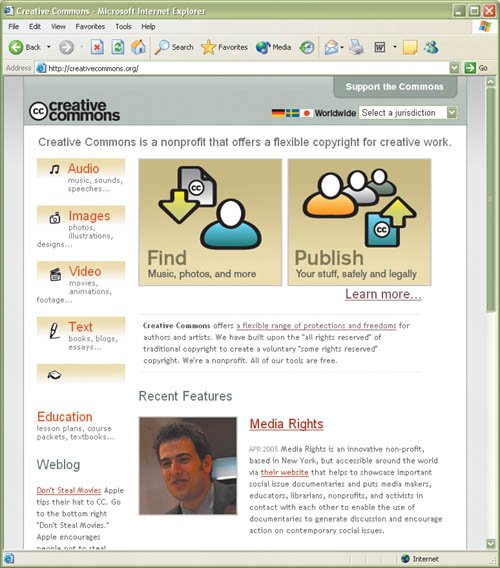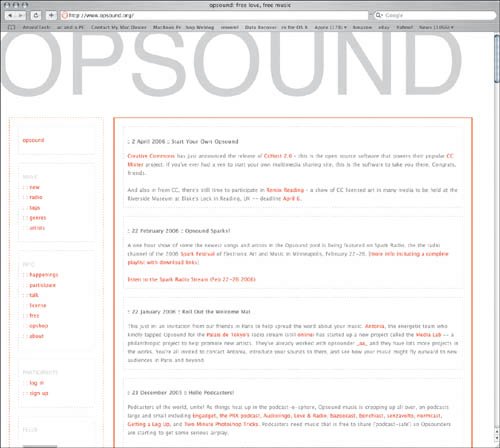Music
| Music is a very important part of podcasting. After all, many podcasts are like terrestrial radio broadcasts, in that they play a selection of popular music. Even for all-talk podcasts, music is often part of the program in one form or another. Although music plays an important role in making podcasts sound professional, there are issues around the licensing of musical content within a podcast. Despite the limitations, there are ways (such as licensing or using Creative Commons licenses) to include music in your podcasts. It's a sticky area, however, and it's important to know the lay of the land before you try to walk across it. LegalitiesFew people may realize this, but each and every time a song is played on the radio, on television, or even at a sporting event, a royalty is paid to the rights holder of that song. How much of a royalty is paid depends on where the song is played. The use of a song in a commercial, such as the Rolling Stones' "Start Me Up" (for Microsoft Windows 2000) or the Beatles' "Revolution" (for a Nike shoe ad), can generate hundreds of thousands or millions of dollars. On the other hand, a radio station playing a particular song might require a payment of only 16 cents. Whatever the cost, royalties are designed to reimburse the creative people who wrote and performed this music. Many songs are owned not by the artists who wrote them, of course, but by large corporations. Either way, the money is owed fair and square. As one might expect, podcasting can throw a wrench into the royalty situation when it comes to music. Are the many mom-and-pop operations creating amateur podcasts still responsible for paying royalties for the music they may use in the background during their shows? If the podcast contains licensable music, the answer is YES. Two main bodies manage royalty collection for music catalogs: ASCAP and BMI. ASCAP (American Society of Composers, Authors and Publishers; Figure 3.50) is a performing-arts organization that acts as a collector and advocate for those artists associated with it. BMI (Broadcast Music, Inc.) is similar to ASCAP in that it represents artists with regard to the collection of royalties for music that is played in public. Surprisingly, despite the sudden appearance and rapid growth of podcasting, both of these organizations have agreements that more or less cover the basics for podcasters. Figure 3.50. ASCAP is the American Society of Composers, Authors and Publishers. ASCAP has a contract known as the ASCAP Experimental License Agreement for Internet Sites & Services, Release 5.0. This license costs a minimum $288 up front and includes fairly complex fee calculations. This contract is offered on a per-year basis, and the fee is not pro-rated, so if you pay $288 on December 20, 2005, you will have to pay $288 again on January 1, 2006. This is a very dynamic area, however, and any of the above details could change even by the time you read this book. To have a look at ASCAP's license, check out www.ascap.com/weblicense. BMI (Figure 3.51) has a similar license that appears to be slightly easier to negotiate. The up-front minimum cost of this license is $295, and of course, there are also fee structures, depending on how music is used in the podcasts. To see BMI's license, go to www.bmi.com/licensing/forms/Internet0105A.pdf. Figure 3.51. BMI's Web site.
Adobe Acrobat is required to view both of these licenses; you can download it free at www.adobe.com/products/acrobat. Bob Goyetche, of "The Bob and AJ Show" fame, says that when it comes to playing music in his show, the team ultimately looked at two alternatives:
It is clear that if you want to create a podcast that includes popular music, and you are interested in proceeding in a legal fashion, you will have to obtain licenses from these organizations and follow the licenses to the letter. That said, it is unclear how many podcasters currently follow these rules. It probably won't surprise anyone if these rules change in the coming months or years. Either way, it is important to stay up to date on this issue if you are an active podcaster. Creative CommonsCreated in 2001 by Lawrence Lessig, Creative Commons (http://creativecommons.org; Figure 3.52) is a not-for-profit organization with the goal of expanding the amount of creative work available for others to build upon and share legally. Creative Commons licenses were originally designed for the United States, but now, Creative Commons licenses can be obtained in 29 countries. Figure 3.52. Creative Commons is an excellent place to find music for your podcasts. This is a new system, built within current copyright law, that allows an individual to share his or her creations with others and to use music, images, and text online that has been identified as having a Creative Commons license. To learn more about the history of Creative Commons, visit http://creativecommons.org/about/history.
It's important to note that getting a license with Creative Commons does not mean giving up your copyright. It means instead that you are giving up some of your rights to any taker, but only under certain conditions. Several of the podcasters I interviewed for this book mentioned Creative Commons as a source for the music they use in their podcasts. If you want to include music in your podcasts, I suggest that you visit the Creative Commons Web site and learn more about what is available. As an artist, you can choose one of several licenses, including:
The Creative Commons Web site can point you to several excellent sites that contain Creative Commonslicensed sound files and music. One such site is Opsound (www.opsound.com; Figure 3.53). This site is an excellent source of music that you can use in your podcasts, provided that you follow the rules of each license. If the idea of reading the license for each song gets under your skin, remember that licensing commercial music is very expensive and requires far more paperwork. Figure 3.53. Opsound is a great site for Creative Commons licensed music.
Most of the music on the Opsound Web site falls under the Share Alike Creative Commons license, which means you are free to download it, share it, and include it in your work as long as you attribute the works to the original authors/musicians. The site also contains some public-domain music. |
EAN: 2147483647
Pages: 89
